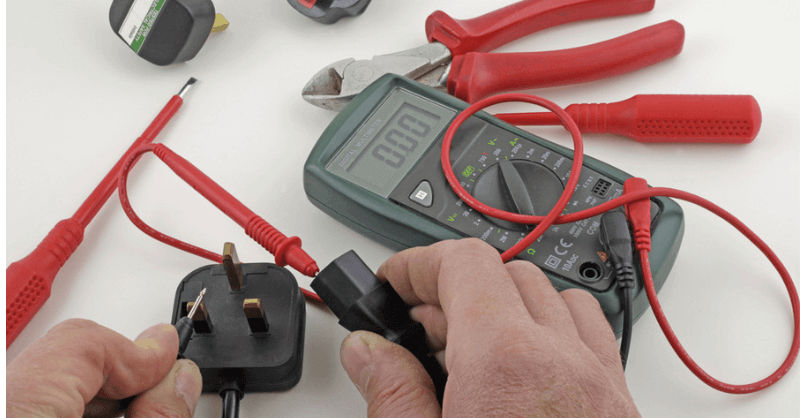Is PAT Testing A Legal Requirement? Health and safety is a major concern for entrepreneurs all around the world. Running a business involves the use of several electrical appliances (almost all businesses do). This may impose the threat of causing an injury with the appliances. So you will have to follow a few government health and safety regulations. This is to prevent practicable dangers from all systems. Portable Appliance Testing (PAT) is the process to secure electrical equipment.
Is PAT Testing A Legal Requirement?
To be honest and precise there is no law that says PAT testing is a legal necessity. Upon a little research on several legislative acts and equipment regulations reveals its true necessity. The law says to maintain proper safety of electrical appliances for human use. This justifies the legitimacy of PAT testing.
Table of contents
What is PAT testing?
PAT testing or portable appliance testing is the inspection of basic electrical appliances. Its main purpose is to check whether they are safe for use.
Portable appliances are electronics that you use in your office or at homes. These are PCs, toasters, televisions, printers, refrigerators etc. These run on electricity. So they can be dangerous if not inspected on a regular basis.
A standard PAT test involves:
- a visual check of the general condition of the appliance
- the current-carrying cables
- the source of the electricity (plug)
The test also includes an in-depth check with special pat testing equipment. This checks the internal current-carrying parts of the appliance.
How is the PAT test conducted?
A PAT test is a routine inspection of electrical appliances to check their safety. A full PAT test includes both visual inspection and in-depth hardware inspection. It is an inspection of current-carrying parts of the appliance to ensure its electrical safety.
There are also tests carried out with an ohmmeter or PAT tester as you may call it, to carry out an in-depth pat test. This mainly produces the readings. They determine the safety of the internal parts of the equipment. This is to prevent the danger of all systems.
Things tested by the PAT tester is:
- Verification of earthing conductivity
- The soundness of insulation test
- Current carrying part and exposed meta (leakage test)
- Testing the current supply source
- Cable and extension lead test
After conducting the test the PAT tester will attach a pass sticker to each of the tested appliances. If the appliance does not pass the test he will fix the fault by himself. If he can’t then he will recommend another service to get it fixed as soon as possible. Some services even offer an e-mailed certification of the conducted tests.
Laws and regulations on PAT testing
There are several myths about how a PAT test fits within the law. This is because there is no PAT testing law that directly recommends the service to business owners. But upon a little digging into the following mentioned acts and regulations, we will be able to bust the myth of PAT testing for you.
The health and safety act at work in 1974
“It is not only the employer’s duty but also the employee’s duty to ensure the safety of anyone else currently using the work premises”
-This regulation also includes self-employed people as well.
This means that the business owner and his employees are to account for the safety of the customers. Their service may include the use of any electronic appliance by the customers. So it is the business owner and the employee’s duty to keep the appliances safe.
The electricity at work regulation 1989
This is the most well-defined act that covers the testing of electrical equipment. It gives a proper outline for business owners and employers. It states the following:
- This is the most well-defined act that covers the testing of electrical equipment. It gives a proper outline for business owners and employers. It states the following:
- All systems should 'be designed' in such a way that it avoids all reasonable dangers.
- The systems must 'be maintained' in such a way that it prevents all reasonable dangers.
- Here ‘by systems’ means equipment connected to a common electric source.
- generate
- transmit
- transform
- rectify
- convert
- distribute
- control
- store
- measure
- conduct
- provide or use electrical energy
So this act here gives an indication that a system shall be maintained for inspection and testing of electronics.
The provision and use of work equipment in 1998
These rules are applicable to the use of work equipment. The rule includes all sorts of work equipment that uses a source of electricity for power. This means all fixed, transportable and portable appliances fall under these criteria.
It is the responsibility of the business owner to ensure the work equipment ‘is maintained’ in an:
- Efficient state
- In a good working order
- And in good repair
The management of health and safety at work regulations 1999
This law states the employer to :
Assess the health and safety of employees according to the dangers they ‘are exposed’ to.
It is the owner’s duty to ensure the health and safety of personnel in the business premises. This is even applicable for people not under his employment but fall under the same danger parameter.
So from the above rules, we see it is the employer’s responsibility to ensure safety. The owner has to assess the dangers of the environment the employees and customers might face.
Thus, by analysing the above acts and regulations, we can say PAT testing is not directed by the law. But it is a legal obligation to carry out a PAT test to meet the safety at work regulations in the UK.
What appliances need to be PAT tested?
Portable appliances are all equipment that is not part of a fixed installation such as a generator. Any appliance that uses a flexible cable or a plug and socket for power qualifies as a portable appliance.
That is all appliances that have a cable or plug and use a socket to get power is a portable appliance and qualifies for PAT testing.
Yet the legislation does not define portable appliances specifically. It says all types of electronics that can pose a threat to humans health and safety. So the term portable appliance may seem misleading in some cases. Keeping this in mind there are 5 categories of appliances that require PAT testing. These are:
Fixed appliances: A fixed appliance is an electrical appliance which is connected to the electricity supply. It may be a fused outlet to which the flex is permanently connected. Some examples of fixed appliances are machine tools, cookers or electric ovens, hand dryers etc.
Stationary appliances: These are the appliances which cannot be easily moved from one place to another. These are refrigerators, window air conditioner, washing machines etc
Handheld appliance: A few typical examples of handheld appliances are gaming consoles, smartphones, tablets etc. They cannot be PAT tested; they consist of rechargeable batteries. It poses the threat of explosion at any time due to an imbalance of power. So any kind of charger and power cables should be tested for any defects.
IT appliance: It is necessary to test All IT Equipment that uses electricity(most of them). Testing is also needed for all networking equipment, detachable power cord and peripherals. This is to ensure full and proper safety.
Portable or movable appliance: A portable appliance is an appliance that can ‘be moved’ from one place to another. They are plugged in for use such as photocopy machines, printers, PCs etc.
The appliances stated above will need proper inspection and testing at regular intervals. Whether they are for domestic use or commercial it is mandatory to ensure their safety.
PAT testing frequency
The main considerations to keep in mind while determining the frequency of a PAT test is:
- The type of the appliance
- How frequent they 'are used'
- Based on any complaints from its users
Appliances used in offices, homes and shops are normally inspected at a gap of 12-48 months. The occurrence of these inspections depends on the type of equipment they are. Normal home appliances can be checked after 48 months if no fault arises. But appliances in offices such as printers, photocopiers, coffee machines and electric kettles should be tested more frequently. This depends on how often they are being used.
It is necessary to check IT, stationary and portable computers every 12 months. Inspection of Portable, fixed and handheld appliances used in industries should take place every 6 months.
Why is PAT testing important?
Current carrying parts are very sensitive. Anything that has the possibility to go wrong will definitely go wrong sooner or later if kept unchecked.
PAT testing is the examination of electrical appliances and equipment to make sure that they are safe for use. Electrical appliances play a pivotal role in the modern-day lifestyle. To maintain their Safety is a basic priority. This is mandatory to lead a healthy and safe life. Maintaining the PAT testing rules also sets high business standards.
Who needs pat testing?
The legislative rules say you have to maintain electrical equipment intended to be used for commercial purposes. Especially the ones that have the potential to cause an injury. This is to keep the workplace in a safe condition.
So it is the responsibility of business owners, to ensure a safe workplace. The responsibilities include regulating the safety of employees and customers.
So it is necessary to maintain portable appliances in the workplace. This includes a photocopy machine to an electric kettle and everything between.
Another group of businessmen who should consider PAT testing as an annual practice is landlords and hotel owners. As they are lending out accommodation to people. Since they operate as a business they should also consider the safety of their tenants as well.
A PAT engineer will know exactly how and where to look for in commercial accommodation or workplace. It is his job to mark and check all possible sources of disaster.
What qualifications do you need to carry out PAT testing?
The legislative action on health and safety at work directs to conduct tests of electrical appliances by a competent individual. The tests must be done by a person who has adequate knowledge and background on the subject. So the qualifications required in order to conduct a PAT test are as follows:
- Have commanding knowledge over electricity.
- Have experience in electrical works
- Understanding of the systems to 'be worked' on.
- Very good understanding of hazards that can arise without precautions.
- The ability to recognize and fix a problem or suggest a fix for the problem.
PAT testing services
PAT testing services are usually offered to PAT testing contractors by large scale businesses. The contractors assess each of the equipment in the workspace. He then fixes or recommends fixing where necessary. He charges companies based on the number of items and number of fixes.
Besides the large companies, small businesses also need to avail PAT testing services. They recruit individual freelancer technicians and vendors to carry out testing.
PAT testing costs
The cost of such services varies based on the location where the services are available. A call-out may cost as much as £50 to £70 on a minimum inspection of 25-30 items. Additional items may cost as much as 75p-99p per item.
A career in PAT testing
PAT testing is a very handy skill to have especially if you have an interest in the field of electrical and electronics services. Portable appliance tester is a very high on-demand job as almost all the businesses use a big number of electrical appliances. So most companies look to keep a person in their payroll who can offer such services to them all the time.
So qualification as a PAT tester can help you step up your career and enrich your resume. Trade professionals such as plumbers and electricians can also opt for PAT testing. This will upgrade their resume by qualifying as a PAT tester. Altogether it can be an easy skill for individuals looking for an organised profession as a maintenance technician.
Recent posts
- Upskill for Impact: Online Guide to Boosting Your Teaching with Professional Development
- Free Online Courses: How to Study Online Courses for Free in 2024
- Mastering the Dissertation: A Comprehensive Guide to Academic Success
- Challenging Behaviour in the Classroom [Types & Solution]
- The Impact Of Remote Work On Women In The Marketing Industry
- Differentiating Web Design and Web Development
- Top 10 Social Media Management Tools for Businesses in 2024
- Why is Child Development so Important in Early Years
- Line Management: How to be a Good Line Manager?
- How Long Should a Health Sector Career Take?







 May 15, 2020
May 15, 2020








